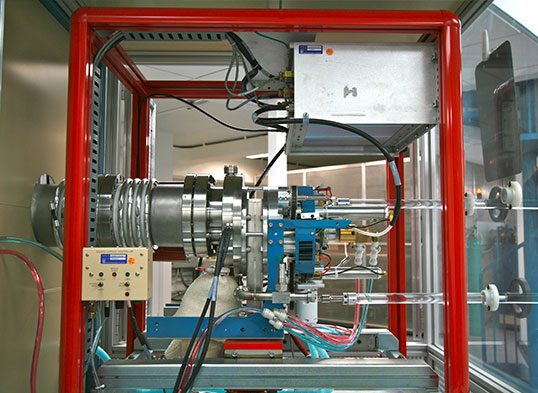
Beta Analytic has been providing routine AMS radiocarbon dating services to the international scientific community since 1983. The company routinely delivers AMS radiocarbon dating results within 14 business days.
The Accelerator Mass Spectrometry (AMS) technique for radiocarbon dating accounts for a substantial number of the analysis requests Beta Analytic receives each day. There can be considerable advantages to using the AMS technique in many dating applications, making it possible to extend radiocarbon dating into many new areas of research. AMS also permits applications in important situations that cannot be dated by the radiometric dating technique.
The AMS measurement is done on graphite produced by hydrogen reduction of the CO2 sample over a cobalt catalyst. The CO2 is obtained from the combustion of the sample at 800°C+ under a 100% oxygen atmosphere. The CO2 is first dried with methanol/dry ice then collected in liquid nitrogen for the subsequent graphitization reaction. The identical reaction is performed on reference standards, internal QA samples, and backgrounds to ensure systematic chemistry.
The analytical result (“BP” or “pMC”) is obtained by measuring sample C14/C13 relative to the C14/C13 in Oxalic Acid II (NIST-4990C) in one of Beta Analytic’s multiple in-house particle accelerators using SNICS ion source. Quality assurance samples are measured along with the unknowns and reported separately in a “QA report“. The radiocarbon dating lab requires results for the QA samples to fall within expectations of the known values prior to accepting and reporting the results for any given sample.
The AMS result is corrected for total fractionation using machine graphite d13C. The d13C reported for the sample is obtained by different ways depending upon the sample material. Solid organics are sub-sampled and converted to CO2 with an elemental analyzer (EA). Water and carbonates are acidified in a gas bench to produce CO2. Both the EA and the gas bench are connected directly to an isotope-ratio mass spectrometer (IRMS). The IRMS performs the separation and measurement of the CO2 masses (44, 45, and 46) and calculation of the sample d13C.
The client’s samples are included in a “full wheel” of graphite targets, including backgrounds, modern and known-age standards prepared by Beta Analytic. These additional materials undergo the same chemical pretreatments and graphite syntheses as client samples. This is indispensable for precision radiocarbon dating. They are interspersed throughout the accelerator wheel to provide reference measurements for the age calculations and verifications. Only with rare exception that it is acceptable to analyze unknowns prepared separately from the reference standards.
Why is it important to do all steps of the analyses in one laboratory?
Disclaimer: This video is hosted in a third-party site and may contain advertising.
Results of AMS carbon 14 dating analysis are reported within 14 business days for the Standard AMS Delivery Service, and within 6 business days for the Priority AMS Delivery Service. The Time-Guide service reports results in 2-3 business days. These quoted delivery times are independent of the quantity of samples sent for radiocarbon dating analysis. When your samples are received, we quote an expected terminal delivery date in a correspondence letting you know the samples arrived safely.
Beta Analytic begins the chemical treatments immediately. At the same time, backgrounds, modern and known-age samples are also being carbon dated. The complete wheel of samples is sent to the accelerator. We then calibrate the results to calendar years, apply isotopic ratio corrections (where needed), and report the carbon 14 dating results to you.
Page Last Updated: August 2022